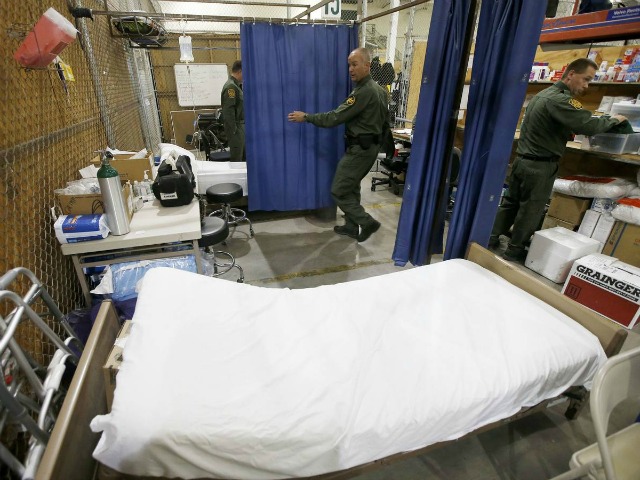
Illegal aliens presumed to have exposed border patrol agents in San Diego, California, to scabies may have been released into the general population, according to a July 4 letter from Ronald Zermeno, director of Health and Safety of a local chapter of the National Border Patrol Council, the union representing Border Patrol agents.
“We do not know exactly which detainee was infected and processed at Brown Field that resulted in the agent contracting this disease,” the letter, sent to Paul Beeson, Chief Patrol agent at the U.S. Border Patrol in Chula Vista, CA, said. “We suspect that they could have been already transferred to ICE custody and may have already been released in the surrounding communities.”
As reported by Breitbart California, two border patrol agents in San Diego contracted scabies from illegal immigrants sent from Texas.
According to the Centers for Disease Control and Prevention:
Human scabies is caused by an infestation of the skin by the human itch mite (Sarcoptes scabiei var. hominis). The microscopic scabies mite burrows into the upper layer of the skin where it lives and lays its eggs. The most common symptoms of scabies are intense itching and a pimple-like skin rash. The scabies mite usually is spread by direct, prolonged, skin-to-skin contact with a person who has scabies.
“We do not encourage releasing the detainees; they should be held for deportation hearings,” Zermeno says. “If ICE is going to release them, then they should be quarantined prior to Ice releasing them into the communities to ensure that they will not transfer infectious diseases such as scabies into our communities,” adding, “I request that your staff not downplay this incident and call it an isolated incident.”
According to Zermeno, one of the agents sent him a picture of the rash he has on his body and advised Zermeno he was diagnosed with scabies by his doctor and had to apply pesticide cream all over his body and leave it on overnight. After the agent went home, he changed out of his clothes in his garage and put his clothes in the washing machine. The next morning, he saw the rash. The agent is married with two small children, Zermeno points out, and carpools with another agent who may also be exposed.
“To make matters worse, the agent put his uniform shirt in the backseat of the vehicle, and now the other agent’s daughter has sat there before they were aware of the infection. Agents were told to trust the medical screenings,” Zermeno writes.
He explains:
I spoke to the agent who advised me that the duties he was performing at the time he thinks he was exposed was that he was asked to do the medical screening of all detainees, prior to releasing them to ICE. He is not a trained medical professional but did the best he could do. He completed the questionnaire on all the detainees and documented what he saw. He observed several people with open sores and which he recorded on the questionnaire. He was not told about any precautions to take such as decontamination of himself and uniform. This demonstrates that we are not properly trained to identify infectious disease and to properly respond when we suspect a disease.
Zermeno reminds Beeson that he stated that all the detainees “underwent health screening by FEMA personnel and were declared medically sound for transportation to California.” He states, “Our EMT Agents did an initial medical screening of the detainees upon their arrival and identified several with active scabies and other illnesses.” The detainees that passed the screening were then sent to other stations in San Diego for processing, one of which was Brown Field Station, where one of the agents contracted scabies.
According to the Centers for Disease Control:
When a person is infested with scabies mites the first time, symptoms may not appear for up to two months after being infested. However, an infested person can transmit scabies, even if they do not have symptoms. Scabies usually is passed by direct, prolonged skin-to-skin contact with an infested person.
However, a person with crusted (Norwegian) scabies can spread the infestation by brief skin-to-skin contact or by exposure to bedding, clothing, or even furniture that he/she has used. Scabies mites generally do not survive more than 2 to 3 days away from human skin. Children and adults usually can return to child care, school, or work the day after treatment
Persons with crusted scabies and their close contacts, including household members, should be treated rapidly and aggressively to avoid outbreaks. Institutional outbreaks can be difficult to control and require a rapid, aggressive, and sustained response.
Rooms used by a patient with crusted scabies should be thoroughly cleaned and vacuumed after use. Environmental disinfestation using pesticide sprays or fogs generally is unnecessary and is discouraged.
Zermeno urges Beeson that doctors medically screen all the detainees and be decontaminated before arriving in California, as well as provide agent training to identify these specific diseases. He also requests Beeson provide assistance for the infected agent and his family.
“Please provide assistance to the infected agent for his losses to include his bedding and clothing.” He asks that “assistance be provided to the agent carpool partner for the decontamination of his vehicle and for both agents to have their families checked for possible exposure.”
Zermeno also warns, “Institutional outbreaks can be difficult to control and require a rapid, aggressive, and sustained response.” Additionally, Zermeno points out that rooms used by a patient with crusted scabies should be thoroughly cleaned and vacuumed after use with proper high-efficiency particulate air (HEPA)-type vacuums.

COMMENTS
Please let us know if you're having issues with commenting.